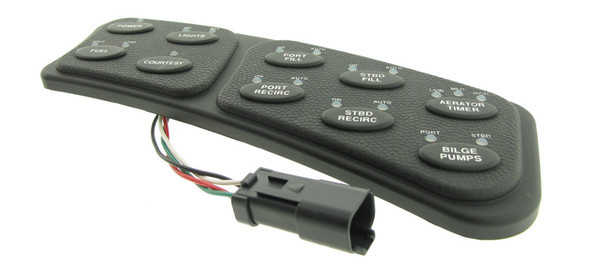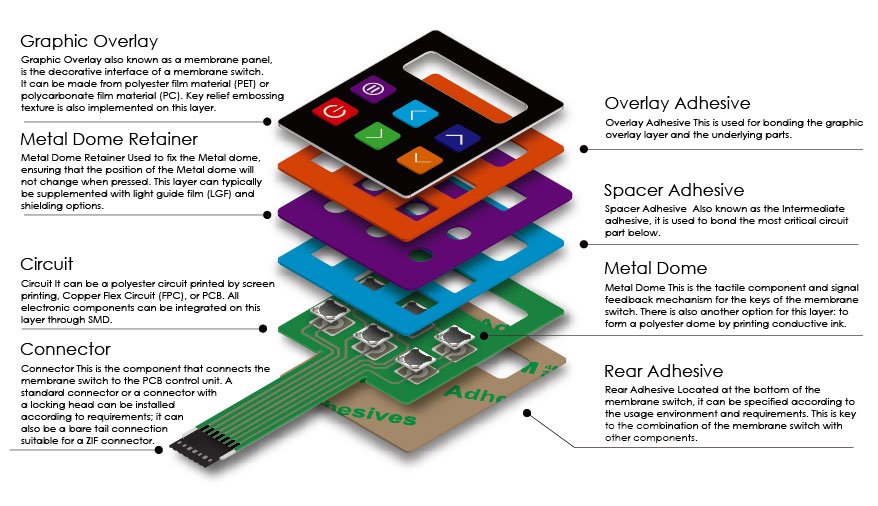Recognizing the Relevance of Membrane Switch Over in Modern Electronic Devices
Membrane switches are indispensable elements in contemporary digital devices. They offer a mix of functionality and design that enhances customer interaction. Their resilient and light-weight nature makes them appropriate for numerous applications. As markets develop, the demand for customization and progressed attributes grows. Recognizing how membrane changes add to technology exposes their significance fit the future of electronic devices. What lies in advance for this innovation?
The Fundamentals of Membrane Switch Technology
Typically neglected, membrane layer switch innovation plays an important duty in the modern-day electronic devices landscape. These tools, composed of multiple layers, offer as interface for numerous electronic items, ranging from house home appliances to medical equipment. A common membrane layer button contains a graphic overlay, a spacer layer, and a circuit layer, which are thoroughly assembled to create a practical interface.When pressure is related to the overlay, the circuit layer is finished, permitting signals to be sent to the device. This technology is recognized for its convenience, making it possible for customization in functionality, style, and form to fulfill particular user requirements. Furthermore, membrane layer buttons are slim and light-weight, making them ideal for applications where room is a costs. Their durability and resistance to ecological elements further enhance their allure, guaranteeing they can endure rough problems while keeping performance. Generally, membrane switch technology is essential to developing efficient and easy to use digital tools

Trick Benefits of Membrane Switches Over
Membrane changes deal numerous essential advantages that make them a favored choice in various digital applications. Their design allows for a small kind element, enabling manufacturers to develop light-weight and streamlined tools. Furthermore, membrane switches are resistant to dirt, moisture, and chemicals, which enhances their sturdiness and longevity in requiring environments. The responsive responses given by these buttons can improve customer experience, making them easy and instinctive to operate.Furthermore, membrane layer switches can be tailored with varied graphics and colors, enabling for special branding chances. The production process is generally cost-efficient, especially for high-volume production, as it reduces assembly time and simplifies style. Membrane switches need marginal upkeep, contributing to lower general operational prices. These advantages emphasize their growing popularity in modern electronic devices, where integrity and straightforward interfaces are vital.

Applications Across Different Industries
The versatility of membrane layer switches over allows their extensive fostering throughout various markets. In the medical field, they are commonly utilized in analysis devices and patient tracking systems, providing a long lasting user interface immune to contaminants. The vehicle industry makes use of membrane buttons for dashboard controls, improving customer experience with smooth layouts that endure severe problems. In consumer electronics, they offer as control board for gadgets such as microwaves and coffee manufacturers, providing an user-friendly user interface that is easy to clean. The aerospace field uses membrane layer buttons in cockpit controls, where reliability and room performance are vital. In addition, the commercial industry leverages these buttons in machinery and control systems to ensure robust procedure in requiring environments. This wide array of applications underscores the adaptability of membrane layer buttons, making them indispensable elements in improving capability and individual communication throughout diverse technological landscapes.
Customization and Design Flexibility

Future Patterns in Membrane Layer Change Advancement
Arising fads in membrane layer button development suggest a growing focus on boosted performance and assimilation with clever modern technologies. As consumer need for more sophisticated digital devices increases, manufacturers are concentrating on creating membrane layer switches that not only offer standard functional functions but likewise include features like touch level of sensitivity, backlighting, and haptic feedback.Furthermore, developments in materials are anticipated to boost durability and ecological resistance, making membrane layer switches ideal for diverse applications in industries such as healthcare, automobile, and consumer electronics. The integration of capacitive touch technology is most likely to end up being a lot more prevalent, permitting for sleeker designs and boosted customer interfaces. membrane switch.Additionally, the rise of the Internet of Things (IoT) is prompting the growth of membrane layer switches over that can connect wirelessly with other devices, enhancing interconnectivity. On the whole, the future of membrane switch innovation shows up promising, driven by development and the pursuit of straightforward services
Frequently Asked Questions
Just How Do Membrane Layer Changes Compare to Conventional Mechanical Buttons?
Membrane buttons, being a lot more space-efficient and using a streamlined design, contrast with conventional mechanical buttons that give responsive comments. The former commonly feature customizable graphics, while the last typically ensure toughness and reliability in different applications.
What Materials Are Generally Made Use Of in Membrane Layer Switch Manufacturing?
Membrane layer buttons are commonly generated using materials such as polyester, polycarbonate, click for source and printed conductive inks. These materials give flexibility, responsiveness, and toughness, making them ideal for numerous applications in electronic devices and interface.
Can Membrane Layer Changes Be Fixed or Reused?
Membrane layer buttons can often be repaired, especially if minor problems emerge, such as glue failure or surface area damage. Total reuse is normally limited due to use and prospective destruction of products over time.
Exactly How Do Environmental Aspects Impact Membrane Layer Change Performance?
Ecological factors, such as temperature, exposure, and click for more info moisture to chemicals, considerably affect membrane layer switch performance. Extreme problems can lead to destruction, affecting responsiveness and long life, ultimately compromising the capability of the device in numerous applications.
What Is the Common Lifespan of a Membrane Switch over?
The normal life expectancy of a membrane button usually varies from 1 to 5 million actuations, depending upon variables such as usage regularity, environmental problems, and the materials utilized in production, influencing toughness and efficiency longevity. A regular membrane layer button is composed of a visuals overlay, a spacer layer, and a circuit layer, which are diligently constructed to produce a functional interface - membrane switch.When stress is used to the overlay, the circuit layer is completed, enabling signals to be sent to the device. The tactile comments supplied by these buttons can enhance user experience, making them simple and user-friendly to operate.Furthermore, membrane layer switches can be personalized with diverse graphics and shades, permitting for one-of-a-kind branding opportunities. As customer need for much more sophisticated digital gadgets rises, manufacturers are concentrating on producing membrane layer switches that not just offer standard operational roles but additionally include attributes like touch sensitivity, backlighting, and haptic feedback.Furthermore, developments in materials are expected to boost sturdiness and environmental resistance, making membrane layer switches over suitable for diverse applications in sectors such as medical care, automotive, and consumer electronics. The integration of capacitive touch modern technology is most likely to come to be more widespread, enabling for sleeker layouts and enhanced customer interfaces.Additionally, the increase of the Net of Things (IoT) is prompting the development of membrane layer changes that can communicate wirelessly with various other devices, my sources boosting interconnectivity. Membrane buttons, being much more space-efficient and providing a streamlined layout, comparison with traditional mechanical switches that give responsive comments